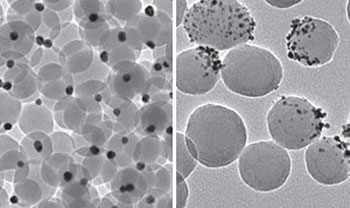Janus Nanoparticles in Advanced Material Science
Definition: Janus nanoparticles, named after the Roman god with two faces, are nanoscale particles with two distinct sides, each exhibiting different chemical or physical properties. This duality enables unique interactions with their environment, making them highly versatile for applications in targeted drug delivery, nanomedicine, catalysis, and as functional components in complex nanostructures.

Definition and Principle of Operation
Janus nanoparticles are engineered by combining two or more distinct materials at the nanoscale to create a particle with two faces, each showing different characteristics. This asymmetry allows for multifunctionality within a single particle, where one side may possess properties like hydrophobicity, while the other side may be hydrophilic, enabling complex behaviors in response to environmental stimuli.
How Do Janus Nanoparticles Work?
The unique functionality of Janus nanoparticles arises from their structural asymmetry, allowing them to simultaneously interact with diverse chemical environments or to perform multiple tasks. For example, in a biological setting, one side of the particle can be designed to target specific cells, while the other side carries a therapeutic agent. This dual functionality is achieved through sophisticated synthesis techniques that control the composition and morphology of each side of the nanoparticles.
Key Features of Janus Nanoparticles
Key advantages of Janus nanoparticles include:
- Targeted Delivery and Controlled Release: Their ability to encapsulate drugs and release them at specific sites makes them ideal candidates for targeted therapy, reducing side effects and improving drug efficacy.
- Environmental Sensitivity: Janus nanoparticles can respond to environmental changes, such as pH or temperature, enabling smart drug delivery systems and sensors.
- High Surface Activity: The distinct surfaces of Janus nanoparticles make them effective as catalysts, promoting reactions by providing active sites with varied characteristics.
- Versatility in Applications: Their unique properties are exploited in fields ranging from nanomedicine to environmental remediation, showcasing their broad utility.
Limitations of Janus Nanoparticles
Challenges associated with Janus nanoparticles include:
- Synthesis Complexity: Crafting nanoparticles with precise control over the distinct functionalities of each side requires sophisticated and often expensive techniques.
- Stability Issues: Maintaining the stability of Janus nanoparticles, especially in biological environments, can be challenging due to their complex structures.
Applications of Janus Nanoparticles
The multifunctionality of Janus nanoparticles has led to diverse applications, highlighted by specific examples:
- Targeted Drug Delivery: Janus nanoparticles have been employed to enhance the targeted delivery of chemotherapy drugs, such as doxorubicin, to cancer cells. By attaching targeting ligands to one side of the nanoparticles, they can selectively bind to cancer cells and release the drug directly into the tumor, minimizing the impact on healthy cells.
- Diagnostic Tools: Their environmental responsiveness makes them suitable for biosensing applications, aiding in the detection of diseases at the nanoscale.
- Catalysis: In catalysis, Janus nanoparticles have been used to drive photocatalytic reactions for water purification. One side of the nanoparticle is designed to absorb sunlight and generate reactive oxygen species, while the other side facilitates the degradation of pollutants.
- Self-Assembly: Their anisotropic nature enables the formation of complex, ordered structures with potential applications in materials science and nanotechnology.
As research advances, the exploration of Janus nanoparticles continues to uncover new possibilities, driving innovation in drug delivery, sensing technologies, and beyond. Their unique properties and broad applicability underscore the potential of Janus nanoparticles to revolutionize fields from targeted therapy to environmental science.
Further Reading
Coordination Chemistry Reviews, Preparation and application of Janus nanoparticles: Recent development and prospects
Critical Reviews in Food Science and Nutrition, Janus particles: A review of their applications in food and medicine
